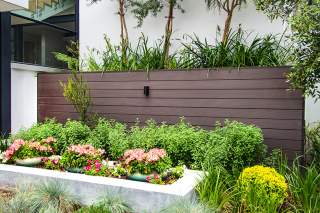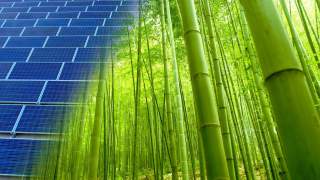how to make living spaces truly come alive
There are many definitions of ‘green’ as it pertains to buildings, but the latest sustainable lifestyle trend toward living walls and living roofs has the ultimate credentials in low-impact living. Rather than being quite literally a statement façade, there are sound reasons for bringing plants into our architectural designs.
Living walls and roofs – otherwise known as green walls and roofs or even ecowalls and ecoroofs – can be either free-standing or attached to wall and roof surfaces, in horizontal or vertical designs and can be planted in soil or use hydroponic systems to provide drip irrigation to the plants selected for the design.
Green walls are typically built using a suitable skeletal structure of supports and watering grid to keep the plants healthy. Choosing the types of plants to hang on green walls is much like choosing a paint colour – only with much more variation possible. The benefits of bringing green walls into living spaces are manifold – from cleaning the air we breathe to reducing ambient noise that would ordinarily bounce off of hard walls, to providing an aesthetically pleasing natural environment.
The temperature fluctuation control, insulation and UV light reflection properties of green roofs are where nature really comes into its own – reducing household energy requirements for climate control in the process. The collective benefit of green roofs in an urban area is the reduction of what is called the ‘heat island effect’ that occurs in cities, where a typical lack of vegetation causes urban areas to be considerably hotter than naturally green areas.
For buildings with suitable rooftops, green roof designs can provide even more benefits, from vegetable planter boxes to natural climate control and a beautiful private recreation space that increases a home’s traditional living area. Adding green walls and green roofs is one way to eliminate ‘sick building syndrome’, which can be summed up as that dreary feeling of living in an artificial environment that is both boring and adds nothing to our health and enjoyment of living. This is especially the case where green walls can be added to office and workspaces.
“Even adding plant boxes, trellises and green trims to a living space can make a considerable difference to one’s quality of life. Not every house is perfectly suited to installing a fully green roof, but we are certainly seeing how property owners are becoming creative with using building materials to bring nature closer to the home,” says the CEO and co-founder of building materials group Eva-Last, Marc Minne.
“Sustainable living elements in homes are now fetching a premium on the market because of the range of features they provide, from energy cost reductions to aesthetic beauty and health benefits. We are pleased to see so many people using Eva-Last’s environmentally sustainable products to form the frameworks for green installations,” he adds.
Eva-Last’s composite building products combine the fast-growing and easily replenished fibres from bamboo with recycled plastic and aluminium materials to provide light, structurally strong and durable building products such as cladding, decking and architectural beams, which are synergistic in designing and creating a green living environment.
“Sustainable elements are changing the face of the urban landscape by providing both new and retrofitted green elements that bring the natural functions of vegetation into our living and social areas. This trend is long overdue, given the benefits greenery has for improving quality of life, decreasing stress and smoothing the flow between natural and built areas to make sure that our cities are sustainable,” says Minne.
Spring Month is Green Month - Preserve Our Trees!
In South Africa, September celebrates a number of significant events including Arbor Week, with the Department of Agriculture, Land Reform and Rural Development (DALRR) acting as the country’s champion of indigenous forests and trees.
September also sees the World Environmental Health Day and other international reminders of our need to manage our natural resources sustainably and combat accelerating climate change.
The DALRR has called for the public and organisations to get involved in greening their communities and partnering with local government and community-based organisations to coordinate the planting, care and management of all vegetation across urban and rural areas.
The department notes that trees provide more than just ornamental beauty in our open spaces. They provide benefits such as building materials, paper, fibre, oils, gums, syrups, pharmaceutical products, fruit and nuts while also preventing soil erosion. Trees also produce oxygen while using up environmentally detrimental carbon dioxide – they are the filters of our planet.
Incredibly, trees also provide rich nutrients for our soil through fallen leaves, they reduce flooding from rainfall run-off, they lessen sound pollution by deflecting sound waves, act as a windbreak and insulator during harsh weather, as well as providing habitats for wildlife.
In these ways, trees help to not only clean our air, but to reduce our energy costs, improve the productivity of our soils, preserve water supplies and contribute to a beautiful, liveable planet. According to Forestry South Africa, a forest producing 10m3 of wood per year will remove the carbon from the equivalent of 14 million m3 of air each year.
Hardwood trees grow extremely slowly and can reach tremendous sizes – capable of doing incredible work for our environment and impossible to replace in their function. Nathan Chapman, co-founder of sustainable building materials group Eva-Last, says this is why the industry needs to champion the use of alternative materials that protect our natural forests.
“Years ago, timber was in favour in construction and architecture for its look and feel, but it is clear that environmental sustainability and climate change imperatives outweigh any possible aesthetic benefits of using natural timber. At the same time, composite products for decking, cladding and other architectural finishes have come such a long way that they give away nothing in look and feel to real wood. There really is no reason to select timber any more,” says Chapman.
Eva-Last’s range of decking, cladding and beams includes some of the most advanced profile technology on the market. “It’s not just about the look and feel of the product. Over the last two decades we have introduced several patents that improve profile strength across framework spans while reducing profile weight and increasing product longevity significantly, even in the harshest environmental conditions. Our composite alternatives are also highly rated for fire resistance and non-slip surfaces, so in all ways these products are advancements on what timber can offer as a building material,” says Chapman.
He says warranties on Eva-Last products like the Apex range have expanded to cover three decades of use. “This is just unthinkable with real wood, which requires constant maintenance and upkeep, as well as being susceptible to warping, cracking, fading, staining, moisture ingress and destruction by environmental threats like termites. Now, decking, fencing, screening and railing can be put up and left up, requiring nothing more than the occasional clean, as a feature of a property that will not deteriorate or look scruffy in a few years.”
Eva-Last’s Apex, Infinity and Eva-Tech decking ranges are also secured with the company’s proprietary fasteners, under the Hulk brand, which ensure a consistent, flawless and invisible fastening finish. “This eliminates another key drawback of natural timber, which is that it is prone to cracking and coming loose from its fasteners over time, through weather cycles and under heavy use. With some of the most natural-looking, lightest and most durable products ever created available to customers these days, a truly sustainable approach to beautiful architecture and construction is possible – with none of the drawbacks,” says Chapman.



